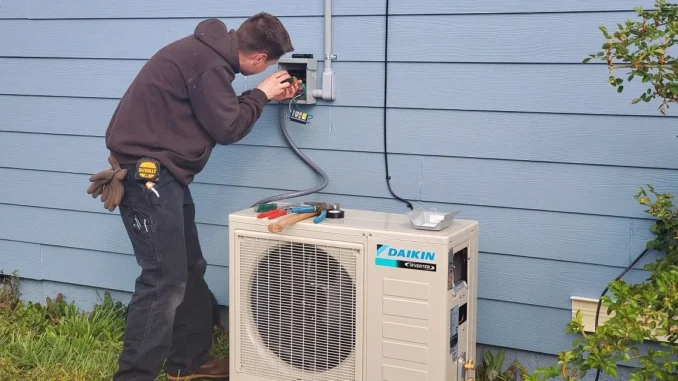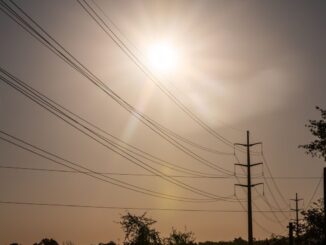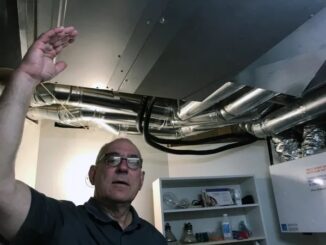
Environmental agencies in nine states will work together to reduce planet-warming carbon emissions by making electric heat pumps the norm for most new home HVAC equipment sales by 2040.
The memorandum of understanding, spearheaded by the inter-agency nonprofit Northeast States for Coordinated Air Use Management, or NESCAUM, was released today and signed by officials in California, Colorado, Maine, Maryland, Massachusetts, New Jersey, New York, Oregon and Rhode Island.
While it is not legally binding and does not commit particular funding, the agreement calls for heat pumps to make up 90% of residential heating, air conditioning and water heating sales in these states by 2040.
An interim goal of 65% by 2030 is based on last fall’s target from the U.S. Climate Alliance, a group of 25 governors, to quadruple their states’ heat pump installations to 20 million in the same timeframe.
The residential sector is one of the top two or three contributors to greenhouse gas emissions in most of the East Coast states signing on to the agreement, driven in part by cold climates and a heavy reliance on oil and gas for home heating. Residential emissions rank far lower in the Western states participating.
In a press release, NESCAUM emphasized the harmful smog, haze and ozone driven by nitrogen oxide and particulate emissions from fossil fuel combustion, calling buildings “a hidden source of air pollution.”
Senior policy advisor Emily Levin said states must move quickly to help residents replace these fossil-fired HVAC and water heating systems with heat pumps in time to limit the harms of global warming.
“You may only have one more crack at these buildings between now and 2050, because these are long-lived pieces of equipment — they can last 10 or 20 years,” she said. “So we really can’t miss our opportunity.”
Matt Casale, senior manager of market transformation with the Building Decarbonization Coalition, said the new agreement’s market-share approach adds specificity to how states will meet existing, number-based goals for heat pump installations.
“The idea is to send a clear signal to the market that heat pumps are the future of home heating and cooling, while reflecting the urgency with which we need to act to meet GHG emissions reduction targets,” he said.
Manufacturers have called for this kind of “long-term signal,” said Levin — “they need to plan, they need to make significant investments.” She said agreements like this show companies that “this is the direction we need to go in” and that state governments are committed to helping make the transition happen.
“Greater demand for heat pumps will also put pressure on installers,” Casale added. “We will need policies that both grow and further develop the workforce. The MOU is a great opportunity to bring them in more directly, learn from them, and talk about their needs.”
Under the new agreement, participating states will “collaborate to collect market data, track progress, and develop an action plan within a year to support the widespread electrification of residential buildings,” according to NESCAUM.
Afton Vigue, a spokesperson for the Maine Governor’s Energy Office, said taking advantage of consolidated industry data will help prevent another new reporting requirement for participating states and will help align with varying state metrics.
The states’ forthcoming action plan is expected to include emphasis on workforce development and supply chain constraints, which have tempered otherwise strong heat pump progress in states like Maine.
“It really does focus on that element of driving the market and collaborating with manufacturers,” Levin said. “Right now, states don’t really necessarily know … how their heat pump market is developing. Creating systems to bring visibility to that, provide insights into that … it’s a really important element.”
The agreement tees up annual reports on each state’s progress toward the 2030 and 2040 goals, and schedules a 2028 check-in about any necessary adjustments.
“A greater focus on consumer education, workforce development, and affordability will be critical to the success of the transition,” said Casale. “This means getting the most out of the Inflation Reduction Act and other incentive programs, but we also need to answer the questions of how this solution best serves multi-family buildings, renters and others for whom purchasing a new system isn’t entirely within their control.”
In the agreement, the states pledge to put at least 40% of energy efficiency and electrification investments toward disadvantaged communities — those facing high energy cost burdens or disproportionate pollution — in line with the federal Justice40 program, which underlies similar rules for the IRA.
Working through NESCAUM and other existing groups, the participating states will brainstorm tools for reaching these goals, potentially including funding for whole-home retrofits, building code enforcement and other uniform standards, data collection, research projects, use of federal resources and more.
“It’s going to look a little different in every state,” Levin said. “But they’re committing to collaborate and to advance a set of policies and programs that work for their state to accomplish those broader goals.”
This could include adapting or building on each other’s approaches. Levin highlighted Maine and California as having successful models for consumer outreach and heat pump market coordination, and said Maryland has shown strong impact and ambition around clean building performance standards.
Maine, which relies more on heating oil than any other state, is among the participants with existing heat pump goals in their climate plans. The state surpassed an initial target — 100,000 installations by 2025 — last year, and now aims to install 175,000 more heat pumps by 2027.
Officials in Maine have said that heating oil use appears to be slowly falling in concert with increasing use of electricity for home heat. Vigue said the new agreement lines up with existing state goals and will help Maine “bolster our ongoing collaboration with other states, share experiences, and see where gaps may exist.”



